(Written by Geneva – gid617)
If you read my previous articles you know that I have been working on a series of LEGO amusement park mash-up projects by combining sets from different themes (see links at the end of this post). So far, we discussed mixing sets from LEGO Friends and LEGO Ninjago, LEGO Creator and LEGO City Space Exploration, and another LEGO Friends set with a LEGO Marvel Super Heroes set. Since every amusement park needs a roller coaster, it’s time to take a look at building one. But first, we need some tracks!
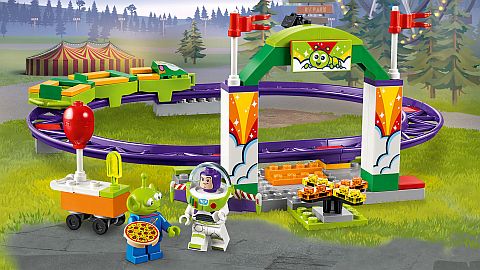
Fortunately, a completely new system of LEGO tracks specifically designed for coasters was introduced a couple of years ago. They are still relatively rare, so instead of going right into the next mash-up session, we’ll take a look at the challenges of building a roller coaster with the tracks from the #10771 LEGO Toy Story 4 Carnival Thrill Coaster and the #41456 LEGO Unikitty Unikingdom Fairground Fun!

These two sets include six curves, two slopes (one convex and one concave), and two short straight pieces of track in purple. Previously, we’ve seen a full purple track in the #70922 LEGO Batman The Joker Manor, but it was an expensive set. There are also red, light-grey, and azure tracks in several sets, and even one piece of yellow, but when I sat down and calculated the most efficient way to get tracks, I figured that with these two sets I’d get a perfect purple figure eight.
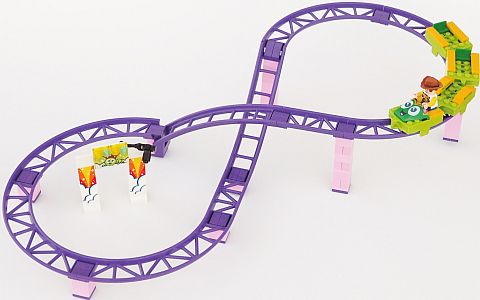
Sure enough, I got a figure eight, but it has some issues. Woody (from #10770 LEGO Toy Story 4 Buzz & Woody’s Carnival Mania) kindly offered to demonstrate the problem.
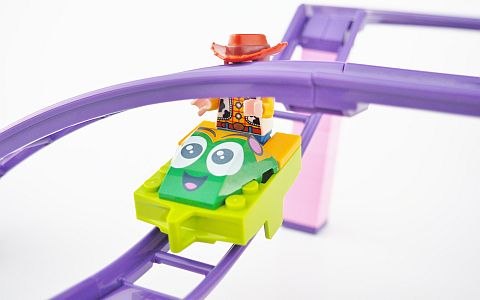
An empty car can pass underneath the section where the loops meet without difficulty, but a minifigure… not so much. So much for my figure eight idea!

The above track looks much better. Plus I have two spare pieces of curved track which I know exactly what to do with. And now let’s address the elephant in the room…
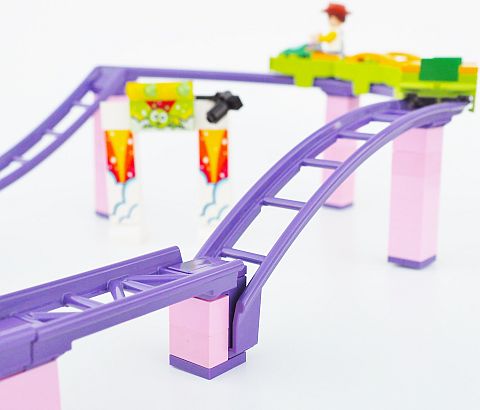
What’s with the gap, you ask? Well, it would have been pretty simple to connect the rails, but that forms an impossible angle. No car can go either up or down. This way, although there’s a gap that makes for a minor bump, a little bit of directed pressure is enough to keep the cars on track. If you don’t want to have to apply pressure, you could build a platform for boarding or maybe a fun cave for the coaster to roll through, narrow enough to guide the cars and keep them from falling over in either direction.
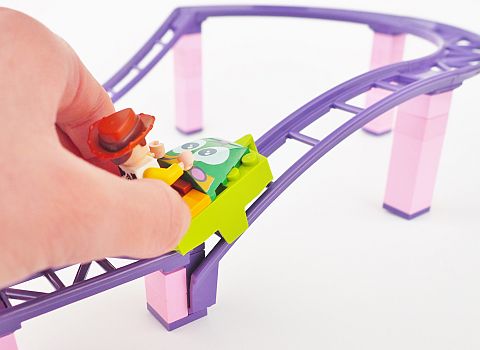
This gap does mean that the coaster direction is locked in. If you try to slide the cars down the slope, they get caught at the gap. No big deal – it makes sense to go up the convex slope anyway.
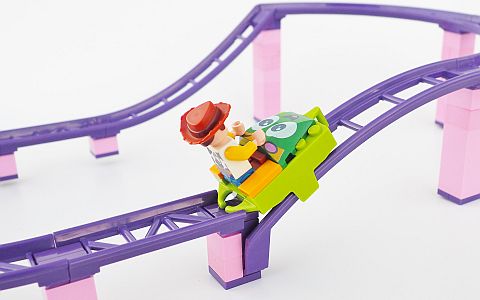
Another thing to note is that sinking the bottom of the slope lower than the rails messes with the height of the coaster. In other words, both slope pieces are the same length from the top of the rail to the bottom, so after artificially shortening this one I’ve twisted the whole track. Not a critical difficulty since it’s easy to spread the inequality out without stressing the pieces much. If you look closely at the pictures of the whole track, you’ll notice that the supports are different lengths on opposite sides.
The reason the angle at the bottom of the convex curve is so sharp is because the convex and concave pieces are meant to attach to each other for a long slope. So not only does the bottom of the convex piece form a sharp angle, the top of concave piece does too. As you can see in the next picture, the top of the concave piece is sharp enough that a coaster with more than one car buckles and can’t make it down (or up) the slope.
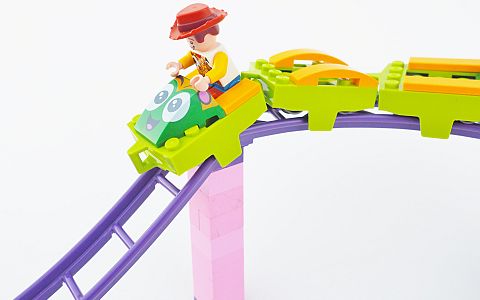
So we’re down to a simple loop (no figure eight), a slight gap at the bottom of the convex piece, only one working direction, and an angle that forces the coaster to be only one car long. It’s worth remarking that a second copy of #41456 LEGO Unikitty Unikingdom Fairground Fun would fix all these problems, since then you would have two convex and two concave slopes and your coaster could run smoothly twice as high.
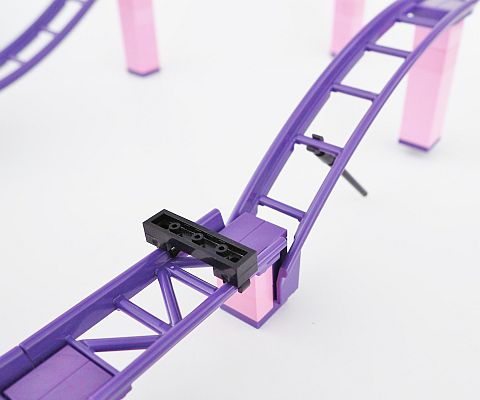
There are a couple other things to note about these tracks – each track is four studs wide, and laced with bars that are just the right size for a clip. The cars roll considerably above the bars in between rails, so you can attach a clip anywhere there and still have your coaster pass by, except in the very middle where the cars have a tongue for motorizing purposes. It’s also possible to attach clips to the rails, but of course this brings the car to a stop. I attached two clips on a 4×1 plate here, but do note that because the rails are sloping out, this stresses the clips slightly.
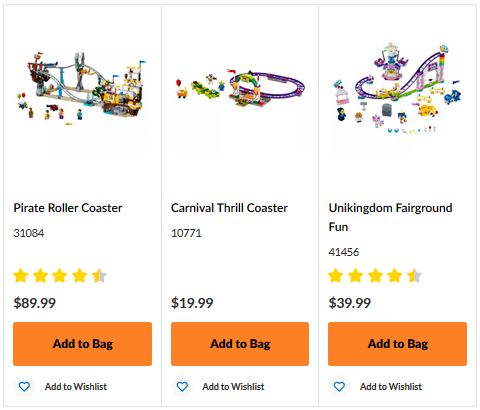
So much for the difficulties involved in building a LEGO roller coaster! Next time, we’ll look at the solution – I warn you, it may be a little wacky, but it’ll be fun! And now it’s your turn to share! Have you experimented with the new roller coaster tracks yet? Did you run into any of issues? What do you think about the new system as a whole? Feel free to share your thoughts and discuss in the comment section below!
And you might also like to check out the following related posts:
- LEGO Set Mash-Up: Combining Friends & Ninjago
- LEGO Set Mash-Up: Combining Creator & City
- LEGO Set Mash-Up: Combining Friends & Marvel
- Brick Breakdown: LEGO Pirate Roller Coaster
- Brick Breakdown: LEGO Roller Coaster
- LEGO Creator Pirate Roller Coaster review
- LEGO Creator Roller Coaster available now!
- Combining three LEGO roller coasters












This is super interesting. I was thinking of making a figure 8 too, but it appears it won’t work. Thanks for saving me the trouble. lol.
haha, yep, unless you decide to use microfigures… ;P
If I get two Unikingdom sets than can I make a figure eight without the minifig hitting his head?
Not with just the two Unikingdom sets – you’ll be missing two curves and two straight pieces. In any case it will be a little tight. Without having two myself, I can’t be absolutely sure, but as best I can tell, with the help of the two short pieces of straight track from the Toy Story 4 set you will have about three inches of clearance which is enough for a car and a minifigure, but if you would like to build something onto the car you may run into issues.
The more straight pieces of track you have the easier it will be to clear the slope, since you can run flat underneath it and start to climb after you’ve already passed under. Of course, straight pieces also distort the figure 8 a little. Notice the placement of the straight pieces on mine for an example.
Thank you. This is very helpful. I might just get some track pieces from bricklink and experiment with those.
Hmmm, judging by Bricklink, there’s only the color Red that contains a complete assortment of all the seven roller coaster track parts. The assortment for the other colors, is as follows:
Azure – 3 parts
Gray – 6 parts
Purple – 5 parts
Yellow – 1 part
Yes, the steep track pieces only come in red. They’re pretty useful if you want to motorize the ride so if that’s your thing, better stick to the red track!
This might not be a bad way to try out the pieces. I have been holding off because the sets with tracks are so expensive. But I would sure love to play with them.
Yes, if you’re interested in alternative uses for the track the small Toy Story set is a great way to get some of the simpler pieces! The short straight pieces seem especially useful.
So, how does the gap work? You can just slide the cart over it? I don’t understand that part.
Yes, you can slide the cart over – but you have to be holding it. You can’t just push it and let it roll.
I’m curious to see how you’re going to mash up the roller coaster with other sets. Ad a spaceship? an Italian restaurant? a serpent? Or all of the above? I’m waiting…..
It’s coming! 😉
It’s pretty cool that you were able to solve some of those problems, even if the solutions are not perfect. When stuff like this happens to me, sometimes I think about it for a long time. Even dream about it! haha!
Actually, I put the basic coaster track together before I started any of the other mashups, so I was thinking it over it in the back of my head for weeks! Plus, I got some creative help from my siblings. It was actually my nine year old sister who came up with the solution of leaving a gap between rails for the steep incline!
I don’t recall dreaming about it, though you never know… 😛